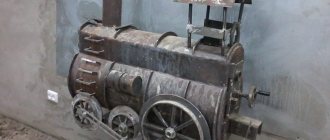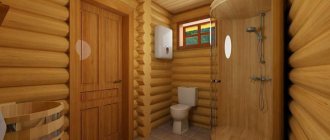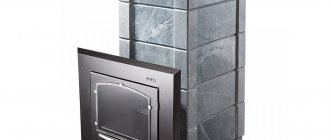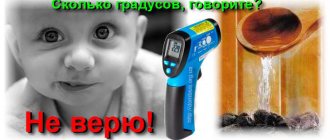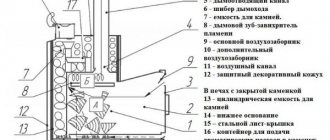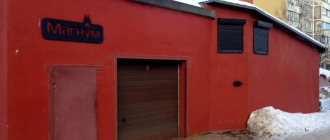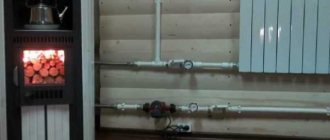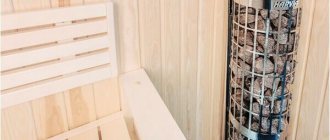As you know, firewood runs out at the most inopportune moment and it is not easy to quickly buy fuel of the required quality. What to do, how to insure against unforeseen situations? To realize such desires, a combined stove must certainly appear in your bathhouse. Damn versatile design.
Gas-wood models
Combined sauna stoves using gas and wood appeared on the market relatively recently. Not all buyers have yet appreciated all the advantages of this type of device.
Stoves that operate on both wood and gas have approximately the same structure.
They consist of:
- outer shell – casing;
- metal firebox;
- ash box;
- main door;
- container for laying stones;
- gas burner elements (burner, filters, valves);
- fuel receiver
Principle of operation
In stoves of this type, both wood and gas can be used. You can start heating with logs or wood chips, and only then turn on automatic gas temperature maintenance. Or you can do without solid fuel altogether and use only gas. Such models are more modernized.
The principle of operation is as follows: due to air circulation, the heat that accumulated earlier is radiated. The furnace walls become very hot. To avoid their deformation, they are coated with heat-resistant paint. Due to the fact that such a stove is equipped with elements for solid and liquid fuels, it is very convenient to use.
There are several varieties of this type of device:
- reconfigurable;
- paired;
- monoblock;
- exclusive modifications.
The first devices are equipped with a removable gas burner block. These are ordinary gas devices, but if the buyer wishes, they can be equipped with equipment for burning wood.
Paired design schemes of the following type make it possible to later convert them to a specific type of fuel. If you don’t like the versatility of the stove, you can change it for gas supply or heating exclusively with wood.
In monoblock designs, there is only one common firebox for burning wood and gas. Such stoves appeared on the market relatively recently and have not yet gained the trust of buyers.
Some bathhouse owners are converting ordinary Russian stoves to gas-wood stoves. This is how various modifications appear, the functionality and safety of which are very questionable. Due to deformation of the brick from gas fuel, defects may appear and the device may not operate properly.
Criterias of choice
A combined sauna stove must meet the following parameters:
- quality. Even the most beautiful and easy-to-use design will become a pointless purchase if it is made from low-quality materials.
- no chips, cracks or dents. The presence of defects will significantly reduce the performance of the furnace and can become a health hazard. Damage to the metal or seams of the device should alert the buyer and make him refuse to purchase. After all, the gas used in the furnace can harm others.
- technical characteristics of the gas burner. Burner consumption plays an important role. Preference should be given to a product with a flow rate of up to 4 cubic meters per hour.
- product warranty. A manufacturer who is confident in the quality of its products will certainly provide a guarantee for this product. It is not recommended to buy devices of dubious origin.
- price. A good, durable gas-wood-burning sauna stove is not cheap. If you are offered a product with a low price, you should think about its quality.
The most popular are the following models:
- Sauna stove HEAT Extragas. Made of steel. Has a heated volume of 32 m³. Price from 27,000 rub.
- Hephaestus stove PB-01. Power 18 kW. Made of cast iron. Requires brick lining. Price from 60,000 rub.
- Ermak Uralochka 20. Made of steel. There is an automatic mode. Cost from 20,000 rub.
- Gas-wood sauna stove P-20GT. Steel body. For steam rooms with medium area. Cost from 19,000 rub.
- Model P-32GT. Made of steel 5 mm thick. For medium-sized double rooms. Price – from 19,000 rubles.
What you need to know when choosing
When choosing a combined heating system for a bath that is suitable for your needs, you should proceed from the following criteria:
- In the vast majority of cases, it is worth abandoning inexpensive and handicraft products. The possibility of gas leaks and the formation of an extremely explosive gas-air mixture or electric shock in such instances is very likely;
- Give preference to Scandinavian, German, Finnish or Italian manufacturers. It is clear that given the current exchange rate, the price of branded stoves will be extremely high, but as the British say: “we are not so rich people that we would buy cheap things.” Worth a listen;
- There is no need to choose Chinese crafts or products of vague domestic origin, especially in terms of monoblock-type gas-wood stoves;
- Pay attention to the little things. The fittings used, the quality of automation, the general production culture. Take the time to inquire about the grade of metal in the “hot” parts of the stove.
The dilemma in choosing the type of heating should partly dissipate after reading this table:
| Type of fuel | Specific heat of combustion, kW | Equivalent to natural gas |
| Electricity | 1,0 | 0,108 |
| Natural gas | 9,3 | — |
| Liquefied gas | 12,5 | 1,350 |
| Freshly cut wood, humidity 55% | 2,2 | 0,243 |
| Dried wood, humidity 20% | 3,9 | 0,425 |
| Wood pellets | 4,7 | 0,513 |
| Straw pellets | 4,0 | 0,433 |
| Wood chips | 3,0 | 0,326 |
Thus, taking 1 kW of electricity as a starting point, you can calculate the calorific value for each specific type of fuel, and using current prices for a particular fuel in your region, calculate the economic efficiency of using a particular heating option.
Electric wood burning devices
A combined sauna stove can operate not only on gas, but also on electricity. Such devices are economical and environmentally friendly.
Electric wood stoves are devices made using modern materials and technologies. These combined sauna stoves use wood and electricity. They are easy to install, environmentally friendly and very convenient to use. Such models are created in order to ensure maximum heat transfer.
The devices consist of two types of parts: solid fuel and electrical. It needs to be lit with wood, and as it burns, the electric heater turns on. It ensures the further operation of the device. There can be two such heaters. They are usually located on the sides of the structure.
Advantages:
- high autonomy;
- duration of operation;
- no need to maintain a fire in the firebox.
Disadvantages include:
- connection by master only;
- electricity costs;
- the cost of the device is almost half the price of a wood-burning stove.
When choosing an electric wood stove, the same considerations apply to a gas wood stove. Only in this case should you pay attention to the electrical equipment of the product. And take into account the load of the device on the electrical network.
It is necessary to pay attention to the country of origin. Finnish, German and Swedish models are especially popular. Domestic manufacturers are just beginning to introduce new products into their production. Considering that these models appeared with us relatively recently, their choice is small.
The best gas stoves for saunas
According to many users, the best stove for a sauna is a gas one. It quickly raises the required temperature, the cost of fuel is low, and starting the stove does not require much effort. But it should be borne in mind that to install such a stove you will need permission from the relevant services, and the installation must be carried out by specialists. Improper installation or maintenance will make this oven dangerous. The quality of the device itself plays an equally important role. According to user reviews, two models are recognized as the best among gas furnaces.
TMF Urengoy
A sauna stove from a well-known domestic manufacturer is constantly being modified. The current model is characterized by high thermal efficiency and safety. Due to the streamlined, rounded shape of the heater, gases do not accumulate in the chamber, but are immediately discharged out through the chimney. There are no stagnant zones in the device, so when restarting, popping noises from accumulated gases are eliminated. Another distinctive feature of the model is its thoughtful design. Externally, the device resembles a regular stove, because there are no pipes outside: they are all securely hidden under a metal casing, and the valves for starting the stove are hidden behind a door made of heat-resistant glass. The model is presented in two colors: discreet silver and brighter brick.
| Heated area | 12 sq.m. |
| Firebox volume | 42 l |
| Size (W/H/D) | 45.1x70.5x64.7 cm |
| Weight | 35 kg |
pros
- the door is covered with durable, high-temperature-resistant glass;
- stylish design;
- compact dimensions allow you to install the stove even in a small bathhouse;
- affordable price;
- There is a choice of body colors.
Minuses
- not suitable for self-installation;
- There are outdated modifications with a not very high level of security.
TMF Taimyr
The gas sauna stove has a power of 32 kW, so it can be used to heat a fairly large sauna with an area of up to 18 square meters. The device is equipped with a closed heater, so the room will always have optimal temperature and humidity, and the air will not be too dry or humid. Externally, the stove looks very neat, since the burner and all other structural elements are hidden under the body and heat-resistant tinted glass. Gas equipment is not included in the stove, but this is more of an advantage than a disadvantage, since each user can choose a gas burner independently, taking into account individual needs.
| Heated area | 18 sq.m. |
| Firebox volume | 26 l |
| Size (W/H/D) | 45x80x74.5 cm |
| Weight | 50 kg |
pros
- the door can be swung from right to left and back;
- outer casing made of durable steel;
- chimney with a diameter of 11.5 cm;
- stylish discreet design;
- proven domestic manufacturer.
Minuses
- some users complain about insufficient temperature rise;
- high cost in comparison with other models of the manufacturer.
Conclusion
In addition to everyone’s favorite wood-burning stoves, there are two more types of room heating in bathhouses. These are gas-wood and electric-wood models. They are ignited using wood, and then switch to automatically maintaining the temperature using gas or wood. The designs of such products are borrowed from foreign countries.
A sauna stove, a gas-wood stove and a device operating with electricity, have one main advantage over their wood-burning predecessors: for their normal operation, they do not require constant addition of firewood. This makes them much easier for owners to use. Such devices cost much more than conventional wood-burning appliances, but the comfort justifies the price.
Furnace materials
The materials chosen for heating are:
- brick;
- cast iron;
- metal.
Brick construction is the simplest option. A brick lining is used, with a chimney and firebox laid. Outdated for domestic buildings. Combustion requires a lot of wood and coal, which is not profitable. Construction requires a professional craftsman; errors affect heating and the safety of residents. To supply hot water, it is wise to use double-circuit wiring. The stove can be upgraded by installing a metal hob on it.
note.
Cast iron is more valuable for the production of stoves. It has good heat transfer and takes a long time to cool down.
Many design options allow you to choose not only in size, but also in design. They have powerful heat output. Suitable fuels include firewood, coal, peat, and diesel fuel.
Metal stoves are more common and cost-effective. Parts of the structure are cut out of metal. Another name is Finnish. The metal heats up evenly and retains heat for a long time. Air channels are created to warm the air. A cold flow enters the lower part, and a hot flow comes out at the upper part. Characterized by their efficiency. It is advisable to use natural wood for combustion.
What are wood-electricity combination boilers?
Mixed-type boilers operating on solid fuel and electricity are always a floor-mounted design, the dimensions corresponding to conventional solid fuel models. Without the use of heating elements (tubular electric heaters), these are ordinary solid fuel boilers that burn not only wood, but also coal, pellets, peat, coke, and anthracite. Piping, installation and connection of universal boilers is carried out similarly to single-fuel boilers.
Cooper Praktik model.
Why are they needed and how are they used?
Heating with electricity is the most expensive. However, if you use it as a backup heat source in a solid fuel boiler, you can get more benefits than might seem at first glance:
- maintaining a comfortable temperature level after burning out solid fuel for a longer period, for example, until the morning if the load burned out at midnight;
- smoothing out the cyclicity of solid fuel boilers, when at the peak of combustion excessive heat output is achieved, and between loads it is greatly reduced. As a result, it is difficult to maintain a constant comfortable temperature level in the house;
- the possibility of faster heating of the coolant while simultaneously using firewood and electricity;
- serious savings in boiler room space, since the installation of two separate single-fuel boilers requires at least 6 m2 of free space.
Unlike gas-wood models, solid fuel and electric boilers are more justified and practically do not differ in cost from conventional solid fuel analogues.
However, if there are financial opportunities, and the space in the boiler room is not limited, we recommend installing two separate boilers, which can be connected in parallel (if the system is with natural circulation) or in series (if a closed heating system with forced circulation of coolant is planned). There are several reasons for this:
- the functionality of a separate electric boiler is much higher, especially when using a room thermostat;
- the block of heating elements reduces the volume of the combustion chamber by an average of 5-15 liters, which affects the burning time of one load;
- The efficiency of heating elements when operating after burning out the load decreases by several percent (from the standard 99%) due to the presence of constant draft in the firebox. In addition, the water jacket in which tubular electric heaters are placed is usually not separated by a layer of thermal insulation, which adds heat loss through the heat exchanger (when the heating unit of even budget electric boilers has a layer of thermal insulation).
Boilers with a burning duration of one load of fuel up to 7 days
Design and principle of operation
Boilers with a built-in heating element have exactly the same design as their classic solid fuel counterparts, with the exception of the space allocated in the water jacket for a block of heating elements, which often means a reduction in the volume of the combustion chamber. The block of tubular electric heaters is removable, the heating part is placed directly in the heat exchanger, and the contacts are brought out through a hole in the wall of the boiler body.
Even 6 kW units operate from a single-phase power supply and are controlled from the boiler, automatically or using a separate control panel, as in the Zota and Teplodar Kupper models.
The operating algorithm is simple:
- When fired with wood or coal, the boiler works like any other solid fuel stove. The draft and temperature levels are maintained by a mechanical thermostat.
- After combustion of the fuel load, the temperature of the coolant drops and, when a critical point is reached, the temperature sensor sends a signal to the heating element block.
- If, while heating the heating elements, a new portion of solid fuel is loaded, the temperature of the coolant will rise and the heating elements will turn off.
This is what a ready-made replacement kit looks like (PU, heating element and wiring) for Zota boilers.
Brick sauna stove: are there any alternatives?
Finally, let's look at what can replace a brick stove in a bathhouse.
Stone stove for a bath
We will not advise you to build the walls of the stove from real stone, but covering an iron stove with slabs of some nice stone is not a bad idea. Such a stove will cost less than a brick stove, but not that much cheaper. The advantage is that it will take up less space and will be easier to maintain. In essence, this is an alternative to a brick casing, which, by the way, is also quite good for creating a suitable stove for a Russian bath.
Stone stove for a bath
Stone casings are sold for a variety of stove models, and if we are talking about homemade products, you can always make a casing to order.
Metal stove + brick pipe
We somehow avoided in this article the question of what kind of chimney should be. It is clear that most people will not put an ordinary sandwich over a brick oven (although there are some). Such a stove requires a brick chimney, with fluff and proper cutting of the ceilings.
However, a heavy and durable brick chimney can also be installed on a regular metal stove, in particular a cast iron one, which is also not bad. More precisely, connect a metal stove to a brick pipe. In other words, the chimney is a different story. Look at the photo to see what its implementation could be like in the above-mentioned combination:
*** So, the decision is yours - there are no ideal stoves in nature, but there are those that suit us. We wish you to find exactly the one that is best for solving certain problems.
Power calculation for a bath
The equipment described can produce different power during operation, and therefore, when choosing a suitable stove, this is the most important criterion.
The required power is determined based on parameters such as the total area of the bathhouse (including the steam room, dressing room and other rooms, if any). The larger the heating area, the more power the stove should have
It is extremely important to make accurate measurements of all parameters of the bathhouse, including its height, width, and chimney diameter.
Power is calculated according to the following principle:
- Multiply the width, length and height of the bath. For example, if a bathhouse is 3x2 in size and 2.2 meters high, then its volume will be 13.2 cubic meters.
- Next, heat loss through a door, window, brickwork or other partitions is calculated. Every square meter of the listed surfaces absorbs heat. To make a calculation, taking this factor into account, you need to multiply the area of the bathhouse by a factor of 1.2. If the steam room has a window whose size is 0.3 * 1.0 m = 0.3 square meters, and a door whose size is 1.8 * 0.8 m = 1.44 square meters, then the total heat loss will be (0.3 square meters + 1.44 square meters) * 1.2 = 2.088 cubic meters.
- The next step is to add the resulting total area of the bath with the area of heat loss. For example: 2 + 2.088 = 15.288 cubic meters.
Based on the data obtained, you can select a furnace of the required power, since manufacturers indicate in the technical data sheet of the equipment what area the furnace power is designed for. It is better to give preference to equipment whose power is in the range of 25 kW.
Design options
Today there are a great variety of different designs of sauna stoves, and many people still cannot decide for themselves which is the best wood-burning stove for a sauna. All of them are divided into two types: brick and metal. Metal ones, in turn, are divided into three more subtypes: cast iron, steel made of carbon steel and steel made of stainless steel.
Made of brick
If a person has a desire to choose a long-burning wood-burning stove for a bathhouse, then the authority of a brick stove for a Russian bathhouse has been indisputable for more than a thousand years. It perfectly accumulates heat and releases it for a long time, warming the room in which it is located.
The heating of the brick occurs very slowly and before this unit begins to give off heat, a lot of wood will need to be burned. A comparative analysis of various heating systems shows that a brick wood-burning unit is more economical than any other.
If you want to have a long-burning wood-burning stove for a bathhouse, you have to buy bricks. Every kilocalorie accumulated by it will be spent wisely, since its heat exchange occurs slowly and even if you touch its walls with your hand, it is quite problematic to get a burn.
This circumstance is an undoubted advantage of a brick stove over any metal ones; they have the highest rating among wood-burning stoves for Russian baths.
The fact is that the so-called steam room is never too large, because the smaller the room, the easier it is to heat it to the desired temperature, which in a Russian bath should be about 120-150 degrees.
Therefore, a steam room is a room in which there is never too much free space and there is always a risk of touching the walls of the stove. Even a blazing hot stone stove for a wood-burning sauna will never cause a burn. If a brick stove is installed in the steam room, then it is no longer a steam room, but a relaxation room, in which all muscles are relaxed and toxins are removed from the body.
Despite the fact that these are the best wood-burning stoves for saunas, they also have their drawbacks, including the following:
- very large mass;
- high price;
- time-consuming work on its construction;
- the need to attract a stove-maker.
Since its mass can reach several tons, a foundation will need to be laid under it. This will inevitably affect its cost, upward.
Cast iron
Not all summer residents have the desire to spend time and money on building a brick stove, preferring to follow the path of least resistance by simply buying a wood-burning heating unit for a sauna in a store, since the choice of stoves for a wood-burning sauna there is very large today.
For fans of the Russian bath, wood-burning stoves from the manufacturer, made of cast iron, are available for sale. Such units most often have fairly thick walls that accumulate heat well and cool slowly. Even with strong heating, they expand very slightly, which allows you to not be afraid of deformation of the product.
The main disadvantage of cast iron stoves is their very large mass. Quite often, wood-burning cast iron sauna stoves, the price of which is quite high, reach a weight of 100 to 200 kilograms. If you add 50 - 60 kilograms of stones to it, you get a rather impressive weight.
Low carbon steel
Stoves made of carbon, heat-resistant steel, wood-burning sauna stoves with a closed heater, including those with an external wood-burning firebox, have significantly less weight. It's hard to say which is better, but they all have the following properties in common:
- they are cheap;
- have a relatively small mass;
- heat up quickly and cool down just as quickly.
Their significant drawback is that with strong heating, when its walls turn red, oxygen burns out from the composition of the steel alloy. It loses its former strength and burns out.
Made of stainless steel
Steel stoves made of alloyed stainless alloys are the most durable, so it has rightfully earned the title of the best hearth for a wood-fired sauna, since even with very high heating, it does not lose oxygen and its metal structure does not change.
The process of heating a stainless steel sheet takes much longer, since this is hampered by its structure. The best wood-burning heating system for a bathhouse is made of stainless steel and heats up quite slowly, which is, in principle, not bad.
However, this also has its own negative side: a stove for a Russian wood-burning bath can crack due to high temperatures, the steel is heated unevenly, which inevitably leads to deformation of the product and the appearance of cracks in the welds.
To avoid this phenomenon, the manufacturer does not recommend accelerated heating of stainless steel stoves.
What is a multi-fuel design and what are its advantages?
Combined sauna stoves come in two main types: gas-wood and electric-wood. The ignition and combustion of such a stove can be carried out using wood fuel, and later, when the wood burns out, maintaining the required temperature rating can be carried out by burning gas or heating electrical elements. Among other things, such systems can operate as a purely wood-burning stove or as a gas or electric one.
Gas-wood heating appliances
Combined stoves for gas-wood baths can be made in several types of design solutions:
- Reconfigurable or modular. A good idea of such a device can be given by a cast iron solid fuel boiler of the KChM type, known since Soviet times. The transition from solid to gaseous fuel was carried out by installing a massive flame divider in the combustion chamber, directing its crown to the heat exchangers and a block of gas injectors, ensuring the preparation and supply of the gas-air mixture to the combustion chamber. The basic principle of operation of such boilers has generally been preserved to this day;
- Paired. Such systems imply the simultaneous presence of elements for operating on gas fuel or wood, without installing an additional fuel module. Features include the presence of two separated fireboxes for the appropriate type of fuel and a single heat exchanger;
- Monoblock systems include a single firebox for burning both types of fuel and a single heat exchanger;
- Other types of structures. They include handicraft, exclusive, non-serial samples that use the most unexpected design solutions, but due to their extreme small number, it makes no practical sense to systematize them.
Twin and monoblock systems are more convenient to use, due to the reduction in real time for transferring heating from one type of fuel to another. Reconfigurable systems are more cumbersome, due to the fact that to start them it is necessary to install or dismantle an additional fuel module.
Electric wood heating appliances
A combined wood-electric sauna stove is more environmentally friendly, practical and safe to use. It has a number of undeniable advantages over its gas rival:
- Such a furnace does not require a gas main and no special ventilation and removal of flue gases.
- Electricity is much safer than natural gas when used in a bathhouse.
- Electric heating is distinguished by a high degree of autonomy and the possibility of very flexible temperature control.
- When operating in electric heating mode, there is no open flame in the firebox and there are no flue gases or fuel combustion products.
- It is very convenient to integrate hot water supply elements with the electrical system.
It should be noted that when installing such combined systems, you must ensure their simultaneous strict compliance with the regulatory requirements of SNiP, PUEP and PPB.
The best electric sauna heaters
Before choosing an electric heater for your sauna, it is recommended to do some pre-planning. For this:
- the steam room is carefully measured;
- if there are no shelves for sitting, a place is immediately allocated for them;
- analyzing the convenience of placing bath accessories and passages, they outline the location of the heater;
- if necessary, changes are made to the drawing related to the organization of electrical wiring and safety.
After this, you can go to the store. Models from the top 3 will show what individual brands offer on the market today.
Narvi NM 600
This Finnish-made electric sauna stove is aimed at fairly large steam rooms. The heater can serve a volume of up to 9 cubic meters. The furnace body is rectangular, elongated in height, made of stainless steel. To maximally protect the user from burns and structural elements from deformation, small diameter heating elements are installed in the system.
Buyers are offered three colors, which will allow the device to fit into the interior. The heater is loaded with 30 kg of cobblestones, the model itself weighs only 10 kg. Such indicators allow you to place the stove on any floor. The only thing the owner needs to do is provide the recommended clearances for ventilation.
- up to 8 cubic meters of room for warming up;
- open heater;
- low weight;
- materials and assembly.
- connection 380v;
- unique tubular heating elements;
- price;
- Gaps are required during installation.
Narvi NM 600 on Yandex Market
SteamGross 1
This model with a steam generator is produced by the Russian brand Teplodar. The stove is massive enough to be carried alone, 32 kg. However, its capabilities are designed for permanent installation. The device can warm up 15 cubic meters of steam room. At the same time, the heat transfer is so great that the stove returns to operating mode within 5 minutes.
The heating elements are tubular, so it is prohibited to turn on the stove before loading the stone. To create the effect of a Russian bath, a steam generator is offered. It can be connected to a centralized water supply network to generate steam with a capacity of 6 liters per hour. All microclimate parameters during steam generation operation are controlled automatically.
- up to 15 cubic meters of heating;
- quite compact;
- 6 powerful heating elements;
- quick access to working mode.
- unique stone;
- steam temperature 400 degrees;
- only 55 kg of stone;
- The power is high for residential wiring.
SteamGross 1 on Yandex Market
KristinaClassic
As mentioned above, today Russian manufacturers offer electric sauna heaters with a good price-functionality ratio. This model from Polytech works with tape heaters. The double stainless steel body has a triangular shape for easy placement in a corner.
For more intense heating of the steam room, the stove has convection pockets. In addition to their main purpose, they serve as additional protection for the user from burns. The model is capable of heating a room with a volume of up to 15 cubic meters.
The manufacturer offers many modifications of the model. They differ both in power and in design of the housing. The most interesting are the rectangular units, lined with natural stone. The devices are powered from a 380V network.
- quality of materials and workmanship;
- tape heaters;
- price/functionality ratio;
- many options for execution.
- power supply 380v;
- stones need to be purchased separately;
- There is a minimum permissible amount of warm-up, you need to choose carefully;
- All accessories must be purchased separately.
KristinaClassic on Yandex Market
Choosing the right metal
Cast iron walls are best suited for a heat-resistant stove, since the metal tolerates high temperatures well and is able to retain heat for a long time. But due to the inflated price, it is often replaced with thicker steel.
It is recommended to take sheet steel with a thickness of at least 10 mm under the bottom of the internal heater. A bottom with a smaller thickness will not withstand high heat for long and will quickly burn out. The consequence will be smoke in the steam room.
The furnace walls must be made of steel with a thickness of 5 mm. With lower values, the service life of the equipment will not exceed 5 years. In factory products, the wall thickness is from 10 mm.
Users often search for:
- Bathhouse decoration
- Covering the bathhouse with clapboard
Installation of a combined stove in a steam room
During installation, it must be taken into account that the requirements for electric or gas and wood-burning structures are summed up. It is imperative to protect the floor under the stove and the adjacent walls from exposure to high temperatures to prevent them from catching fire. For this purpose, asbestos boards are used.
The distance from the stove to easily combustible surfaces must be at least 50 cm. Before the firebox, it is imperative to lay a sheet of metal. Combined stoves require the construction of a chimney, which must be installed at a safe distance from wooden surfaces and carefully insulated.
The chimney pipe is installed at a level of at least 5 m above the firebox and burner. The connection points between the chimney and the stove must be carefully insulated. It is recommended to use sandwich pipes as they are more reliable.
